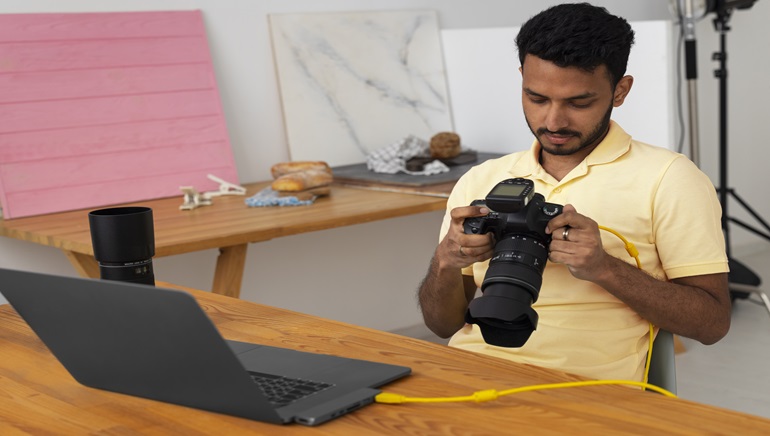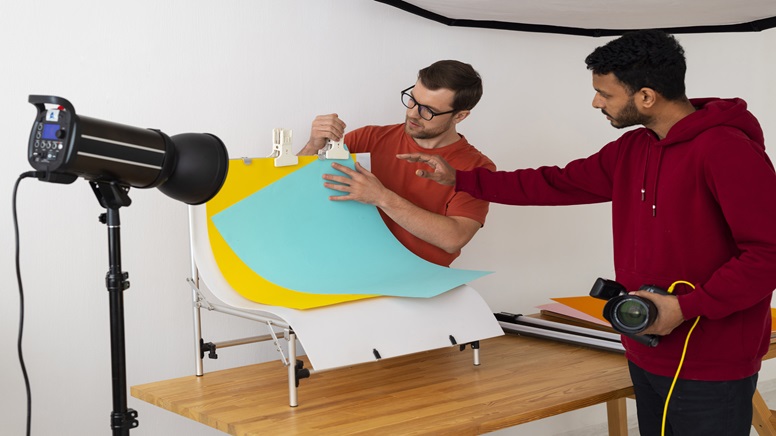How to Choose the Right Photography Course for Your Skill Level
Selecting the right Photography course to follow can influence the kind of growth one is likely to achieve in the specialist field. Exploring the many courses and the essential things to consider will assist the reader no matter if he/she is new to this area or he/she wants to develop expertise in a certain area. This guide will also go through different kinds of right photography courses, things to consider while selecting the course, and how one can get the best value for the course they are paying for.
1. Course Offerings and Types
Foundation Courses/Diploma
These are normally taken by the starting students and normally introduce the student to right photography course. These are the entry-level photography courses that change your orientation by acquainting you with the basics of camera, composition, and lighting. Some hold a diploma in right photography courses that will have a more encompassing curriculum whereby in addition to the basics they will be educated on the different fields of photography.
Advanced Courses
Some of the evening classes available for those who have learned the basics are the post-qualification studies that enable learners to get certain specific education in aspects of right photography courses. Back in the preceding levels, these courses provide an in-depth refresher to other technical skills, creative methods, as well as complex post-processing. Whether you want to get to know some secrets of shooting at weddings or to master new tools of photo editing, an advanced course will be useful.
Wildlife Photography Courses
Wildlife photo enthusiast can participate in right photography courses that are tailored to photographing animals in their natural environment. These courses may include subjects like geography, ethology, observation of animal behavior, techniques of field research, and practice in the usage of equipment required for wildlife photography.
Wedding Photography Courses
Wedding photography courses are intended for learners who have a passion for specializing in taking wedding photos. These comprise issues to do with clients, time management for a certain event, and even the most sensitive and touching moments occasions, and conditions of lighting. Wedding photography services are ever on the rise and if you wish to launch yourself into this business, then a special course is quite useful.
Photojournalism Courses
Mass communication syllabi suited for picture-takers will involve photojournalism classes. These courses involve embedding incognito and reporting events in a manner that captures the rawness and accuracy of events. Right Photography Course have Five major things that you’ll learn at the scene include the ethical issues of photojournalism, the art of telling a story, and the speeds that will be expected of you.
Product Photography Courses
He has also other specialized right photography courses for commerce photography especially in product photography that educates photographers on how to take good quality pictures of products specified for marketing. These courses encompass the lighting setups, composition, and when and how to work with different products.
Future Ready How RVR School of Photography Equips Students for Industry Success By Simran
2. Here are some step-by-step guides on how to find the right Photography Courses for yourself.
Choosing the right photography courses involves several considerations.
Things You Need to Factor When Selecting a Right Photography Course
- Fewer Crowds: The first and maybe the most crucial of the golden hour shooting advantages is the absence of people. Some of the sites that are crowded with people during the day will be found with no people in the morning when such shots are taken.
- Cooler Tones: Also most of the right photography course must know the fact that light during sunrise is less harsh and it is blueish. This leads to the creation of very relaxed and peaceful pictures, probably useful when you want to capture a scene of tranquillity of water, or honeymooners.
- Long Shadows: This is so because at this time, the shadows are long and diffused, thus minimizing uniformity in your pictures. It is possible to use them in a great number of cases to create right photography courses depth using those areas of the picture to which the viewer’s attention is drawn beginning at the center of the screen.
- Perfect for Silhouettes: That’s why, Sunrise Golden Hour is also a great time to start playing with backlighting to get a great silhouette. Have your subject stand in a manner whereby he or she is positioned facing the rising sun and in one position that is parallel to the camera also adjust the settings of your camera so that the background is overexposed to cater for the silhouette outlook.
3. Ontology Assessing Course Syllabi and Curriculum
The type of right photography courses that you choose depends on the syllabus of the course. Ensure that the school or college prospectus has course descriptions containing the complete syllabi that can encompass core and elective subject matters in photography. Make sure that the course allows you to have assignments or projects that you can complete with real-life cases.
Accreditation and Certification, The Reality Of Your Competency
- Cost Analysis: Low exposure or high quality at a relativity low price. Although cost should not be the main criterion, one should find a right photography course that can be affordable and reasonable at the same time. Also ensure that the courses provided give good value for your money in terms of resources, equipment, and backup support after the course.
- Online vs In-Person: As we discussed the different modes of learning it becomes clear which mode better fits you. There are of course pros and cons for attending photography classes online and having to take conventional classroom right photography course.
- Ontology: Assessing Course Syllabi and Curriculum, The type of course that you choose depends on the syllabus of the course. Ensure that the school or college prospectus has course descriptions containing the complete syllabi that can encompass core and elective subject matters in photography. Make sure that the course allows you to have assignments or projects that you can complete with real-life cases.
- Accreditation and Certification: The Reality Of Your Competency, Getting accredited and certified can help enhance your resume and or portfolio signaling the industry’s commitment. Find out if the course gives a certification or if the institution is accredited by well-known photography institutions.
- Cost Analysis: Low exposure or high quality at a relativity low price, Although cost should not be the main criterion, one should find a course that can be affordable and reasonable at the same time. Also ensure that the right photography courses provided give good value for your money in terms of resources, equipment, and backup support after the course.
Related: https://rvrsp.in/product-photography-tips-showcasing-your-products/

4. Course Experience and Resources
Equipment and Resources What Is Offered?
The degree of supplied and required equipment and other resources may differ between different right photography courses. With some, you are allowed to use professional cameras and equipment, while in others, you have to bring your own. Check if the course affordance is sufficient enough to help to complete the assignments within the course.
- Student Reviews and Testimonials: Real Insight Though customer feedback and testimonials are quite effective for any product or service, they can be equally insightful for a chapter-based distance learning right photography course. Search for comments on the quality of the classes and content and the level of satisfaction of previous learners.
- Flexibility and Time Commitment: Think about the number of days and the time of the week or the day, you want the right photography course to be conducted. Less time-consuming programs include; Part-time programs which might be provided or additional evening sessions while other courses can only be pursued on a full-time basis.
- Trusting Your Instincts: The last and perhaps the most important rule in determining which right photography course to take is to decide on what feels right. For a course to be good for you, it should be relevant to your line of work, hobby or aptitude, and absorption method.
Related: https://rvrsp.in/top-photography-tips-for-beginners/

5. Specialized Topics
The Detail Specification of a Working Professional Photographer
Any person who will require the services of a professional photographer should understand that such a right photography course must have certain skills that include technical skills, artistry, and business skills. These are some of the skills that may be developed in specialized courses to enable one to get a good job in the photography field.
When researching for a camera, do not be deceived by people who give you slant information.
If you are being guided by an instructor upon the choice of the right photography course, do not let this person influence your choice of camera equipment. Pay attention to the subject matter and how it can meet your learning goals at the end of the course instead of worrying about the brands and or models of cameras.
Am I Using Appropriate Camera In This Course?
This implies that you must be in a position to ensure that you have right camera and equipment for the right photography course you are undertaking. There could also be courses that require specific type of cameras or lenses, so be aware of such courses before you go out shopping for them.
Group-Based Photography Course Participants
Enrolling in a group-based class will be able to offer the social relations aspect as well as feedback from other learners. Search for classwork that facilitates students to work in groups and be part of teams.
One thing and one thing only that you need to ensure is that you sign up for the best photography course.
Selecting a good photography course to take is paramount to have in your arsenal to be able to accomplish you objective and progress in your newly chosen profession. Always consult, look for a reliable opinion, check for recommendations, and make sure that you have taken your time to come up with the best decision on which photographer course to take.
Conclusion
In choosing the right photography course there are some things to take into consideration such as the content of the course, mode of learning, accreditation, and fees. To help you to reach this decision and lead a rich and fulfilling photographic life, here are the recommendations I set out in this blog.
Clarify Your Doubts (FAQ's)
We reimburse all expenses of the Client for the payment of fines and penalties that were caused by mistakes made by us in accounting and tax accounting and reporting.
We reimburse all expenses of the Client for the payment of fines and penalties that were caused by mistakes made by us in accounting and tax accounting and reporting.
We reimburse all expenses of the Client for the payment of fines and penalties that were caused by mistakes made by us in accounting and tax accounting and reporting.
We reimburse all expenses of the Client for the payment of fines and penalties that were caused by mistakes made by us in accounting and tax accounting and reporting.
We reimburse all expenses of the Client for the payment of fines and penalties that were caused by mistakes made by us in accounting and tax accounting and reporting.
We reimburse all expenses of the Client for the payment of fines and penalties that were caused by mistakes made by us in accounting and tax accounting and reporting.
We reimburse all expenses of the Client for the payment of fines and penalties that were caused by mistakes made by us in accounting and tax accounting and reporting.
We reimburse all expenses of the Client for the payment of fines and penalties that were caused by mistakes made by us in accounting and tax accounting and reporting.

